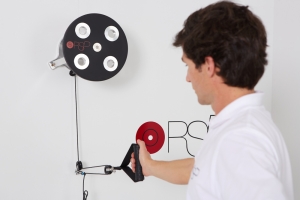RSP WALL
Our upper body workout machines
ABOUT RSP WALL GO
Fixed radius machines have the particularity that the axis is the same during the whole stroke, so all the variations in the acceleration of the machine depend on the capacity of the sportsman to apply force in that movement.
They have a more structural orientation at a muscular level as they work slower than a conic pulley machine and allow for more time of tension as they have a lower acceleration and therefore slower movements. To emphasize on this fundamental characteristic in the fixed radius machines is by using the 1×2 transmission that requires the athlete to apply more force and to increase the time of tension during the entire path of the movement.
The less accelerated movements makes it easier at a technical level for people with little experience in inertial training, making this machine a great tool for the non- sporting population to benefit from inertial training.
HOW TO ADJUST THE RSP WALL GO?
Fixed radio machines have only one way to vary the load of the machine and therefore the response of the machine is the same as to the force applied by the athlete:
– Varying the Moment of inertia: the moment of inertia is defined as the minimum value of force that the athlete has to apply to vary the machine’s state of rest, this means that the higher this value is, the more force the athlete has to apply to start and stop the machine, and the more time he will need to stop the machine and start it again (slower the Eccentric/ Concentric transition)
This will mean that as we increase the value of inertia, we will increase the time of tension and the value of force that the athlete can apply by making the movement slower.
To find out more about this, see our article
How to adjust the RSP WALL GO
With this machine you will be able to perform all the movements related to the actions of pulling and pushing of the upper body to make these gestures as effective as possible. It is very important to adjust the run of the rope with the movement we want to train, so that the end of the concentric phase (farthest point) coincides with the limit of the rope to keep it always tense and avoid losing tension. To adjust it , either we move closer or further away until we find this point or we adjust the rope with the lenght adjuster.
We must also emphasize the importance of making this adjustment in the body position in which we want to make this movement since all the stabilizing muscles and the lower body will be decisive, acting as fixers to be able to apply force and improve the performance in these movements.
TECHNICAL SPECIFICATIONS
| Size: | 28 x 30 x 30 cm high. |
| Weight: | 5,5 kg. |
| Accessories: | – High load pulleys (high performance at high working densities) – Portability kit (to fix the machine to a solid structure such as goal, trellis, column.. |
| Adaptations: | Customization for specific trainings. |
| Spare parts: | – Chassis pulley – Pulley for a 1×2 transmission – Rope (4 meters) |
| See spare parts and accessories: |
Moments of inertia
| Without masses: | 184,44 Kg/cm² |
| 2 masses: | 221,32 kg/cm² |
| 4 masses: | 258,22 Kg/cm² |
STANDARD EQUIPMENT
– RSP wall chassis
– 2 eyebolts to vary the height of the ropes´ output
– 1 eyebolt for a vertical shot of the rope
– 4 aluminium masses
– Harken Carbo pulley of 29mm Ø in the chassis
– 2 Harken Carbo pulleys of 40mm Ø for a 1×2 transmission
– 4 meters high performance rope with lenght adjuster
– Hand grip
– Wall mounting kit
– Assembly manual


